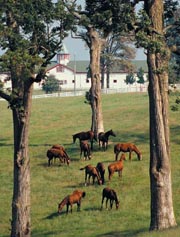 The face of the average horse owner in the United States belongs to a middle-aged married woman, who also has dogs, cats and children. That trend was among the topics during the Kentucky International Equine Summit held in Lexington, Kentucky, April 28 and 29.
The face of the average horse owner in the United States belongs to a middle-aged married woman, who also has dogs, cats and children. That trend was among the topics during the Kentucky International Equine Summit held in Lexington, Kentucky, April 28 and 29.
John Volk, senior consultant with Brakke Consulting in Chicago, said his company’s marketing survey gives the horse industry more information than ever before.“We found that horse owners are more involved in their vocation than just about any other group. They read equine publications, they use the web, and they are impulse buyers. Horsemanship defines horse owners. It’s very much a lifestyle.”
Sponsored by the University of Louisville’s Equine Industry Program, in cooperation with the University of Kentucky’s Equine Initiative, the summit drew speakers from every facet of the equine industry. Two main areas of interest were fragmentation of the equine industry and the need to attract and educate new owners.
“In terms of growth, a lot of times we think taller, bigger, better,” said John Long, CEO of the United State Equestrian Federation (USEF). “But another level we have to consider is horizontal. We have to learn to connect all the silos in the business. (Right now) we have no central voice, and we don’t even have the ability to talk to each other. We share the same interests and concerns, but there is no vehicle to connect us.”
“The challenge is to combine the power and resources of the smaller groups,” noted Martin Concannon, with Lafayette Associates of Lexington. “The key of any business is information, and our fragmentation is holding us back.”
“Many of the issues have been the same the last 30 years,” added John Della Volpe, founder and managing partner for SocialSphere, which works with the National Thoroughbred Racing Association (NTRA). “The difference is that technology can assist us now. It has reach and is affordable.”
Technology is changing the horse world,” agreed Tim Capps of the University of Louisville, who moderated the sessions. “We’re trying to connect with our customers, and connect customers with the horse. We have to reshape our mindset. We’re all marketers and ambassadors and we all have to reach out.”
